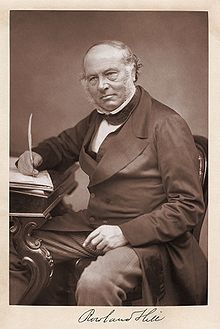The holidays are fast approaching and we all look forward to mailing our gifts. What is the last thing you do once you have a package ready for mailing a gift at the post office? Affix a postage stamp of course!
Ever wondered who invented the postage stamp? And what did the first postage stamp look like? Read on.
 This is Sir Rowland Hill who was born on December 3, 1795 in England at a place called Worcestershire. Those were the days when mail was carried by runners or on cycles and wagons and delivered by hand for a fee. So mail delivery had too many problems such as getting lost, being very slow, difficult to trace and then no proper fee system which would make it sometimes very expensive as per the wishes of the deliverer. So what did Sir Hill do? He created the system we see today in post offices across the world and in 1840, he created the world's first adhesive postage stamp that cost one penny.
This is Sir Rowland Hill who was born on December 3, 1795 in England at a place called Worcestershire. Those were the days when mail was carried by runners or on cycles and wagons and delivered by hand for a fee. So mail delivery had too many problems such as getting lost, being very slow, difficult to trace and then no proper fee system which would make it sometimes very expensive as per the wishes of the deliverer. So what did Sir Hill do? He created the system we see today in post offices across the world and in 1840, he created the world's first adhesive postage stamp that cost one penny.



